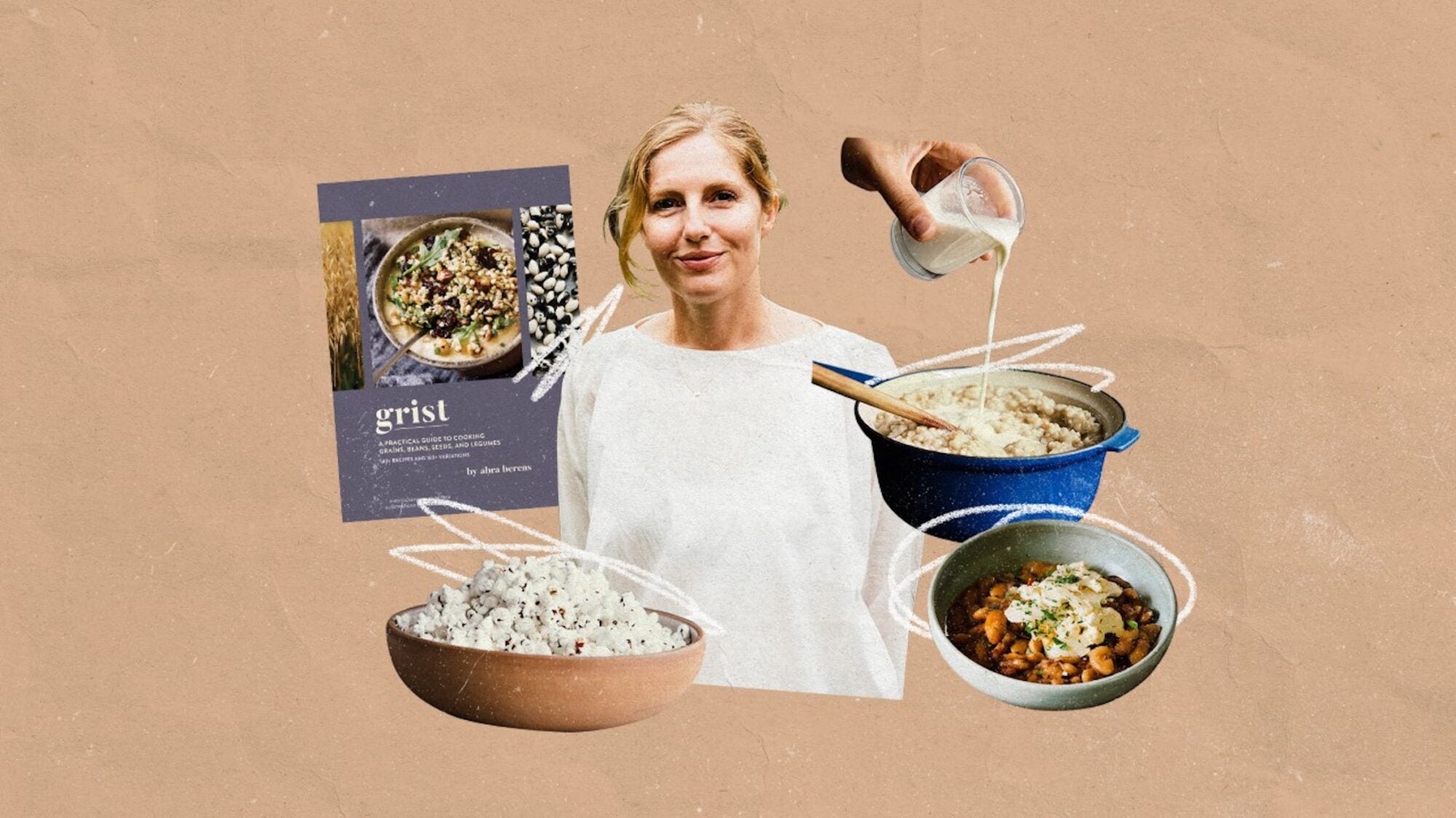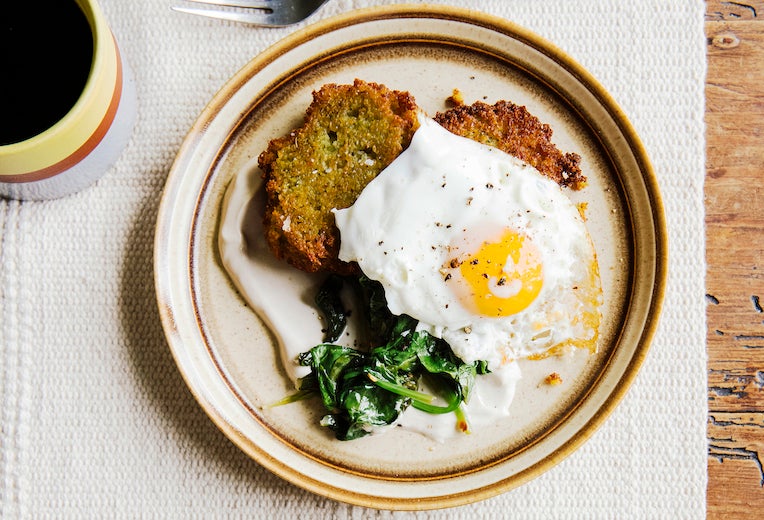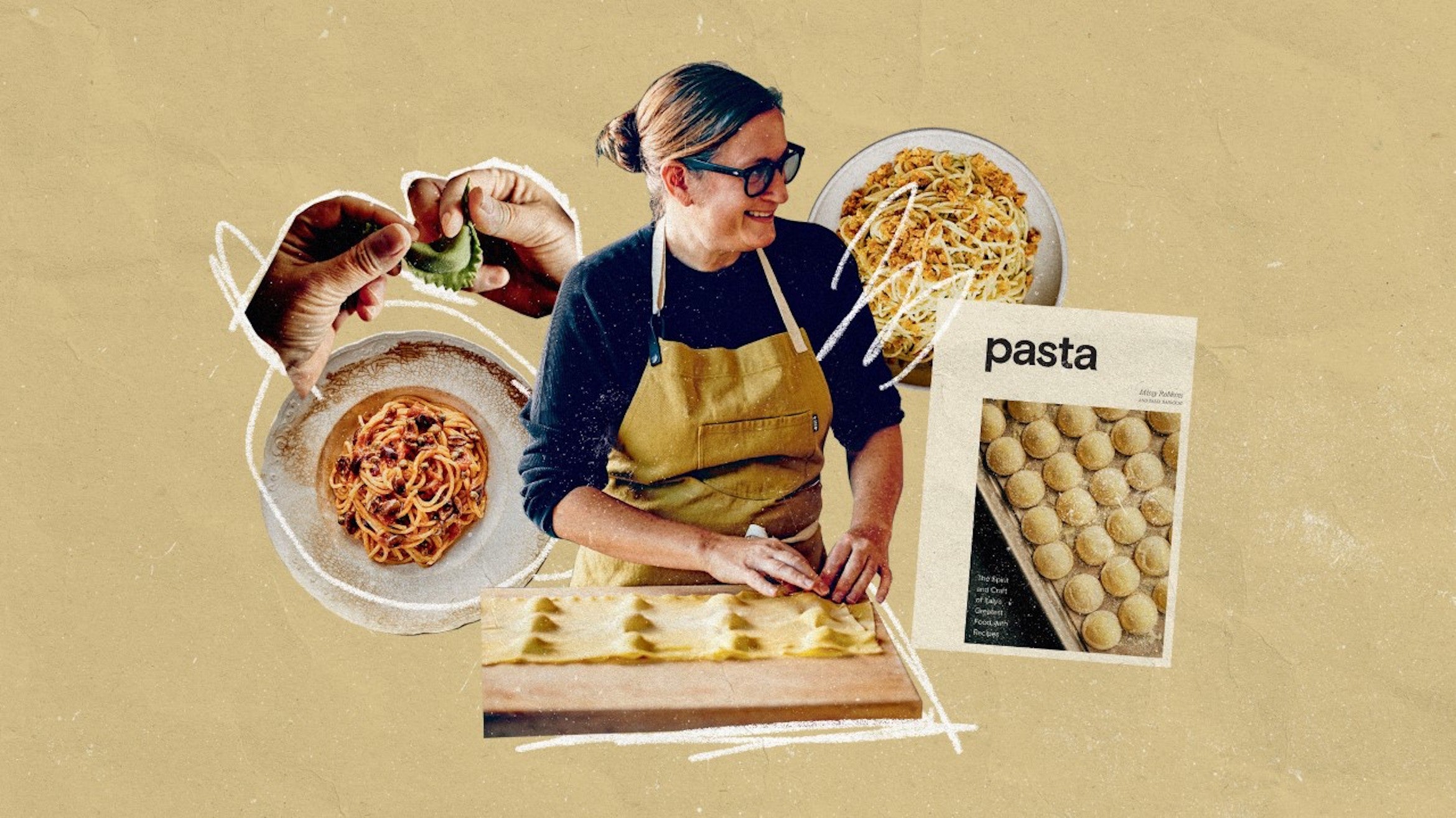
In a new cookbook, chef-farmer Abra Berens thinks deeply about legumes and seeds, with a refreshing sense of creativity.
It’s a cloudless June afternoon in the southwest corner of Michigan, and Abra Berens is walking our group through the literal fields of grain—Turkey Red wheat, to be precise—at Granor Farm in Three Oaks. Berens, a farmer turned chef turned multi-cookbook author, runs the culinary program at Granor and showcases the region’s agricultural diversity through a series of weekly farm dinners. Berens’s inventive cooking, and her deep interest in experimental agriculture and agricultural policy, is a mix of Dan Barber’s Blue Hill at Stone Barns, Christian Puglisi’s Relæ, and a Sweetgreen seasonal salad drop. She places the farm at or near the center of the conversation while striving for the highest level of deliciousness. And she delivers. Her cooking—and, by extension, her book about vegetables, Ruffage, and her new grain and legume-centric collection, Grist, are accessible, but they’re not always simplified. A recipe for buckwheat crepes expands over several pages and includes variations with mascarpone and berries; fried egg and sautéed kale; ratatouille and gruyère; goat cheese, shaved Brussels sprouts, and hazelnut.
Grist treats the chapters devoted to grains, beans, seeds, and legumes like this, giving equal attention to sprouted buckwheat, boiled corn, and wheat berries—each entry including different recipes, meditations, and the occasional farmer interview. It’s the chef’s most-detailed book to date, and a book devoted to Midwestern fruit(!) is scheduled for the next couple of years to complete salad bowl and bread basket trilogy. Post-tour, we sat in the sun on Adirondack chairs and caught up about cooking beans and carb-shaming—and lightly gossiped about our hometown congressmen. (I grew up down the road from Granor in Kalamazoo and lived in the district for almost two decades.) That part was, naturally, off the record.
In your beans chapter, you say that beans are trendy, but you don’t trust us to be “faithful lovers of beans.” I mean, that’s a joke, obviously, so I’m not going to take it literally.
I mean it kind of as is. It started because I was mindlessly scrolling through Instagram, and there were literally four shots in a row of people cooking beans, and I was like, “But what happens after this?” It’s hard, when we think about how that affects growers, because when you put a lot of infrastructure into pivoting to meet a spike in demand, it’s tough. And then, all of a sudden, it’s gone.
It dissipates, and then you’ve built up these infrastructures that can’t be supported.
Yeah. I mean, look at kale. Is the same thing going to happen to beans? It’s a little dramatic to think that, but it’s just like, there is sort of this cool kids’ club around food that I find really frustrating, especially when these really simple products fall into that. Like, if it’s the Cronut or mermaid toast or whatever—
That’s a processed food.
Yeah, I could kind of care less. But when it’s these raw staples, which don’t usually have advocates—they don’t have lobbying forces, the Farm Bureau doesn’t really care—then that does seem tricky to me.
So, kale was overplanted and overseeded and overinvested? And there’s been a pushback, is that what you’re saying?
Well, I think, just in pop culture—for a while, it was hard to get [kale] seed, because there was this uptick in demand for baby kale. And you’re just getting so much less yield out of a baby kale than if you plant a kale plant and harvest from it all year. Now you have people saying, “Cool it with the kale.” So that was the infrastructure thing. I guess my fear was, at what point is it going to be beans?
I think you thread the needle with that answer; it’s a tough one and a long conversation. There’s a perception about cooking with whole grains that carbohydrates are bad; there are diets that literally restrict whole grains. So, for you, what’s the single fact that you want to debunk with your book about cooking with whole grains?
I guess it would be that grains are not evil, and they’re not virtuous—necessarily. They’re just little grains. I think that there’s usually both ends of the spectrum. There are people who will say, “Gluten is killing us.” And then you’ll have other people whose perception of cooking with whole grains is that you have to wear unflattering sandals, and you have to chew them for 20 minutes. And it’s neither of those things. It’s about using them in a way that is pleasant, and that ties back to Ruffage—these things that are considered obligations. You’re supposed to eat a diet that is rich in fruits, vegetables, and whole grains. And a lot of people don’t want to eat that. Why is that? That’s a legitimate feeling, I think. I think a lot of people got turned off of vegetables because they’re often cooked with no fat and no salt or they’re overcooked.
They’re cooked poorly, or they’re mushy.
I think the same is true for whole grains and for a lot of lentils. Some of that is now flipping. Grains can be just pleasurable. That’s why there’s a fried section—because sometimes it’s not like eating a whole grain bowl that’s going to take forever to chew. You can just fry them and pop them, and then scatter them over a salad.
I really liked a point you made. You write that in 1900, 43 percent of our income went to food, as a culture. In 1950, it was 30 percent. And you bring up this really important statistic. You said 9.5 percent—I feel like that’s more than the average, it’s probably 6 percent of our budget that goes to food; not just our disposable income but our actual budget. My question is—and I know you have a really nuanced approach—we can’t just be righteous and say you need to spend all your money on food, because that’s a real have-versus-have-not issue. So, as a follow up to that piece of writing, what is the overall message about spending your hard-earned money on food? Because I thought that was really smart.
Totally. It has to be directed—we can’t talk about it without talking about class. If someone’s going to pay $35 for a cookbook, my gut feeling is that they also probably go to a grocery store where they can afford the food and they like the food; it’s culturally relevant to them. They have the ability to direct their resources. I think it’s that demographic that bears a lot of responsibility. Shifting consumer demand is not to be sneezed at, though it’s not the only thing. There are a lot of significantly larger policies that [Michigan congressman] Fred Upton and [Michigan senator] Debbie Stabenow are part of. But, overall, consumers are a big part of that. And I think that you can drive some of these industry things by voting with your dollars.
“There is sort of this cool kids’ club around food that I find really frustrating, especially when these really simple products fall into that.”
You have meat in the book. There’s not a lot of it, but you do have meat in the book. Why?
I eat meat. My family eats meat. And I think Joe Yonan’s a good counterpoint to this. He’s vegetarian. His book is vegetarian. These books are a manifestation, I think, in the best sense, of the people who are creating them and what they want to put into the world. I thought a lot about it—we thought a lot about it with Ruffage, too: “Should Ruffage be vegetarian?” I think that having some meat in your diet is perfectly healthy. It’s also really good for growers like us.
You write about how you were trained to not salt or acidify beans. But now you’ve seen the light! And you mention that salting and acidifying beans is part of cooking beans. Unpack that a little bit, please.
I was taught in kitchens not to cook them with salt but to add it at the end. But—and I think this is actually a sign of how much the grain and pulses industry has grown—we suddenly have beans that are fresh enough that the salt doesn’t affect them as much. I should have done more reading, called Harold McGee or whatever, to figure out what the science is with that, but it’s the same with soaking. I often forget to soak the beans, and they’re fine; there’s no trouble in skipping the soaking.
The argument was that salting beans while cooking caused a texture issue.
Yeah, it toughened them.
And the Goya beans that you buy at the supermarket might be five years old. But buying beans doesn’t have to be like that.
Right. That’s the conversation I actually had years ago with Grace Singleton, who is one of the managing partners at Zingerman’s Deli; they started bringing in Rancho Gordo and some of these other beans really early on. And she was like, “I know when they’re year-specific, vintaged beans.” That, for her, is the thing that she needs—that they’re vintage. Because she said, “If you get them off the bottom shelf of the grocery store, they’re mixed, they’re blended, you have no idea—that’s why some of them are mush and some of them are hard as rocks. It’s because they’re from all over the place.” I think that that’s where, again, people being passionate about the ingredient and wanting something else leads to a general uptick in a better-quality product being out there. “Better quality” is a little bit of a loaded phrase, but it’s a different product.
I love the condiments, dressings, and vinaigrettes chapter so much, because I feel like it’s really creative and not a throwaway. I think a lot of cookbooks—no hate, but you just throw away certain chapters because you run out of time. How did you come up with those? They’re so fundamental to the first eight or ten recipes.
It was thinking about, again, why do people not like eating whole grains or a bowl of wheat berries? It’s often because they need acidity, some sort of brightness. And it was Erin Stanley, who helps with the dining program and has cooked with me for years now, who pointed out that everything has—not in the cookbook but just in the dinners—some sort of interesting dressing. It’s a way to have the same things come through and then have a new topping that makes it feel different. We started that with Ruffage a little bit, and I think I’m just getting better at doing this. It’s a honed way to present it. I wrote a handful of chapters, found the things that were coming up the most in my mind, then moved those into the condiments section and made sure that they showed up in enough places to make it worthwhile for people to make them.
This interview has been condensed and edited for clarity.
TWO EXCITING RECIPES FROM GRIST
Pea Breakfast Fritters
“If I were really cute and fancy, I’d make these with fried quail eggs and microgreens for an early morning soiree. Turns out I’m neither of those two things, so I make the fritters in big batches and then freeze the leftovers to repurpose when I need something to hold down an all-vegetable meal.”
Pot Licker and Greens
“I tend to love greens and broccolini cooked just enough that they don’t feel raw but are still a bit crisp. Not here. My friend Erin Stanley turned me on to cooking broccolini with some pasta cooking water until it’s just about to fall apart. Swap pot liquor for pasta water, and here we are. Feel free to add some pork or anchovy if you like, but honestly, I don’t anymore.”
MORE BOOKS TO BUY, READ, AND COOK FROM:
- Last week, we caught up with chef Missy Robbins, whose new cookbook, Pasta, distills 25 years of mafaldine mastery into a loving tribute to Italy’s greatest food.
- Hetty McKinnon’s To Asia, With Love has become a quick classic in many of our kitchens since it came out earlier this year.
- In Sheet Cake, Abigail Johnson Dodge proves that the sheet pan really can do it all.
- From one half of the cult comedy duo Tim and Eric comes Foodheim, Eric Wareheim’s culinary bible for modern food freaks, showing you how to throw epic parties, suck the marrow out of life, and cook better than your grandmother.
- In Cooking at Home, David Chang and Priya Krishna embrace frozen foods, the microwave, and improvising as you go.
- Bake your way through Baking with Dorie, the latest book in the Dorie Greenspan canon.

